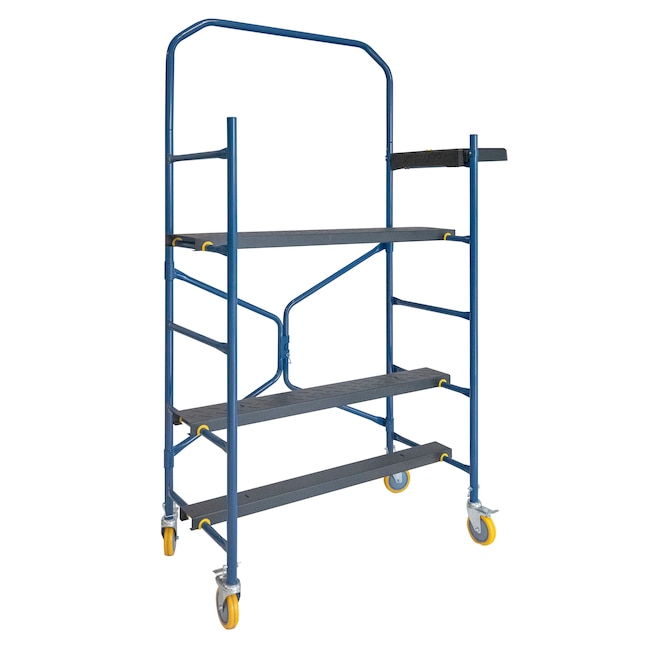Checking Out the Different Sorts Of Scaffolding Utilized in Building Jobs
The building market counts heavily on various kinds of scaffolding to fulfill details job needs, each offering unique benefits and applications. Traditional framework scaffolding gives a durable foundation for general jobs, while suspended scaffolding is vital for work on skyscraper structures.

Traditional Frame Scaffolding
Standard structure scaffolding is one of one of the most extensively made use of techniques in the building market as a result of its effectiveness and versatility. This system includes vertical and horizontal structures that are set up to develop a secure system for workers and products. The main elements include upright messages, straight journals, and diagonal dental braces, which together offer a strong structure that can support substantial loads.
Among the vital advantages of standard frame scaffolding is its adaptability to various building projects, ranging from residential buildings to big commercial frameworks. The modular design permits easy assembly and disassembly, making it effective for both temporary and long-term jobs. In addition, the system can be personalized in elevation and width, suiting different structure designs and site conditions.
Safety is critical in scaffolding applications, and typical frame systems are furnished with guardrails and toe boards to protect against drops and make certain employee security. Furthermore, normal inspections and adherence to security regulations are critical in maintaining the integrity of the scaffold. Overall, standard structure scaffolding remains a fundamental selection in the building and construction market, offering a dependable system for labor and improving general task effectiveness

Suspended Scaffolding
Suspended scaffolding uses a special service for building and construction projects that call for access to raised surface areas, particularly in circumstances where conventional structure scaffolding may be impractical. This kind of scaffolding is typically put on hold from the roof or upper levels of a framework, making use of a system of wheels, platforms, and ropes to develop a functioning space that can be gotten used to different heights.
One of the primary benefits of put on hold scaffolding is its versatility. It can be easily repositioned or decreased to suit modifications in building needs, making it perfect for jobs such as home window installation, façade work, and upkeep on high-rise structures. Additionally, the minimal impact of suspended scaffolding permits far better use of ground area in urban settings, where area is commonly minimal.
Security is an important factor to consider in the usage of suspended scaffolding. Correct rigging and anchoring systems need to be utilized to ensure security and protect against crashes. Operators needs to also be educated in the safe use of this equipment. On the whole, suspended scaffolding provides a reliable and effective option for accessing hard-to-reach areas in numerous construction circumstances, boosting both efficiency and safety and security on website.
System Scaffolding
System scaffolding, commonly concerned as a modern remedy in the scaffolding sector, consists of pre-engineered components that can be promptly put together and adjusted for various construction projects. Scaffolding. This kind of scaffolding is defined by its modular style, which permits versatility and effectiveness on task sites, fitting architectural needs and different elevations
Generally made from high-strength steel or light weight aluminum, system scaffolding offers improved sturdiness and stability. The components consist of vertical articles, straight ledgers, and diagonal dental braces, which adjoin firmly, making sure a robust framework. The design commonly incorporates standard installations, streamlining setting up and disassembly procedures, therefore lowering labor time and costs.

Rolling Scaffolding
Moving scaffolding is a versatile option to typical set scaffolding, made for movement and simplicity of usage on building websites. This kind of scaffolding contains a platform supported by structures with wheels, allowing workers to conveniently relocate it as needed. The wheelchair attribute substantially improves efficiency, as it lessens downtime linked with setting up and dismantling fixed scaffolding.
Normally created from lightweight products such as light weight aluminum or steel, rolling scaffolding uses a sturdy yet mobile service for projects requiring constant repositioning - Scaffolding. It is specifically helpful in jobs such as paint, drywall setup, and electric job, where access to various elevations and places is essential
Safety and security is paramount in rolling scaffolding design, with features such as locking wheels to stop unintended activity when being Scaffolding used, and guardrails to safeguard employees from falls. Furthermore, many designs are adjustable in elevation, fitting various project demands.
Cantilever Scaffolding

The style of cantilever scaffolding usually entails using brackets or arms secured to a structure or framework, making it possible for the system to extend exterior safely. Safety is vital; therefore, these scaffolds have to be crafted to stand up to numerous loads and ecological conditions. Routine examination and maintenance are vital to guarantee architectural integrity and employee safety and security.
Cantilever scaffolding is favored for its versatility and reliable use area, making it a prominent option in urban environments where area restraints are common. In addition, it promotes less complicated access to high elevations, ultimately adding to the total effectiveness of building jobs. As with all scaffolding types, correct training and adherence to safety standards are important for workers utilizing cantilever scaffolding.
Final Thought
Typical structure scaffolding provides security, while suspended scaffolding provides convenience for elevated jobs. System scaffolding helps with fast setting up, and rolling scaffolding enhances flexibility for varying job settings.
Conventional frame scaffolding provides a tough foundation for general jobs, while put on hold scaffolding is important for work on skyscraper frameworks.Rolling scaffolding is a functional choice to typical set scaffolding, created for flexibility and simplicity of usage on building and construction websites. As with all scaffolding kinds, proper training and adherence to security requirements are critical for workers making use of cantilever scaffolding.
Conventional framework scaffolding offers stability, while suspended scaffolding provides convenience for raised tasks. System scaffolding promotes fast assembly, and rolling scaffolding boosts wheelchair for differing job atmospheres.